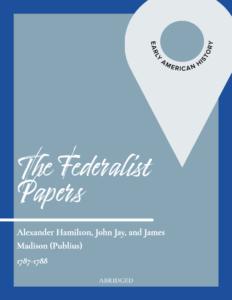
The Constitution of the United States is a paragon of constitutional design.


Capital determines whether a society will be prosperous or poor, well-fed or not, populated by independent and self-reliant citizens or dependent subjects. An abundance of nutritious food, clean water, sturdy homes, safe modes of transportation, reliable sources of heat and power, modern medicines, and many other products and technologies that improve the quality of human life are impossible without capital.
A teacher can help students understand what capital is by encouraging them to think of capital as an individual’s “starter pack” for being productive and getting things done. Capital includes the tools, money, and other valuable resources a person needs to create something of value, or to solve a problem in order to create wealth.
For example, if you wanted to start a lemonade stand, the money you use to buy cups, lemons, water, and a sweetener is capital. While money is an important form of capital, capital can include other resources that help you create wealth for yourself by producing value for others.
Other Kinds of Capital:
Capital is anything you can use to “build” something that will provide experiences of value for other people. Money is the most obvious example of capital, but creativity, friendships, and even your honesty and intelligence, can be just as important, maybe even more important in some circumstances.
So, yes! Capital is cash and more: Capital includes any resource that helps you be more productive. Ask students: What kinds of capital do they have? Maybe it is their energy, ideas, or even their ability to make people laugh. Remind them that everyone—even people with little or no money—have important capital over which each person has much control: A person’s own reputation, honesty, and trustworthiness.
Evaluating incentives
One of the most important questions within any society is: Who will allocate capital? One possibility is that individuals choose whether, how, when, where, and why to spend their own money and invest their own capital. Another option is that political elites within government will tax citizens and confiscate the wealth that others have created, and then those in government will choose how to allocate other people’s their capital.
Individuals choosing how to invest their own capital have strikingly different incentives than politicians and bureaucrats in government spending other people’s money.
As we discuss in another section, profit is the happiness of other people. When individuals and business owners make their own choices about how to allocate and when to invest their own capital, they aim to earn a profit—they want a return on their investment—which is another way of saying they’re trying to make other people happy by producing value for them.
When those in government choose how to spend other people’s money, they serve their own interests, usually by expanding the scope and power of government. That is worth repeating: Business owners allocate their own capital in order to make a profit for themselves by making other people happy; government allocates other people’s capital in order to extend the power and control of government.
Every new government spending program, after all, requires expanding the class of unelected bureaucrats, adding new levels of control over what citizens may do, and adding new kinds of taxpayer-funded government competition to businesses and other private organizations.
Incentives of Allocation
For politicians and bureaucrats, resource allocation often means achieving political ends or aiming for short-term gains. Without direct knowledge of costs or profits, these decisions can be quite unpredictable.
When private individuals choose how to invest or spend their own money, they have strong incentives to make careful, strategic decisions. If they invest wisely, they personally reap the rewards; if they invest foolishly, they suffer the losses. This direct link between decisions and consequences encourages efficiency and accountability. Individuals are motivated to seek the highest return (or best use) for their funds, and they also bear the risk of losing their capital if a project fails.
By contrast, when those in government take capital from citizens through taxation, politicians and bureaucrats end up allocating resources that are not their own. As a result, several distortions can arise:
In short, when individuals allocate their own funds, they have personal incentives—financial risk and reward—to be careful stewards of their capital. When governments collect taxes and decide how to spend them, officials are allocating other people’s funds and often do so under weak or no incentives for efficiency, with less direct accountability for mistakes, and with political or bureaucratic considerations that can overshadow the goal of maximizing societal well-being.
 Nº1
Nº1
Description
Download PDF Download ePub Button 3
The word constitution has two meanings, both of which are important for understanding the conditions of freedom and human flourishing.
When used as a common noun—with a lower-case “c”—constitution has a meaning that stretches back to classical Greek and Roman political philosophy. The constitution of a political community is broader than a written legal document. It embodies the fundamental principles, social structures, and institutional frameworks that collectively define a way of life.
The classical meaning of constitution can include a fundamental written law—such as the United States Constitution, or the basic legal framework of government for any nation—and more:
– What the people within a regime find to be honorable and praiseworthy, and what they believe is shameful and embarrassing;
– Traditions regarding education, vocation, religion, marriage, childrearing, military service, and the rituals surrounding death;
– What citizens (or subjects) understand the ultimate goal of their regime, and the goal of their laws, to be; does their government rule for the interests of one person, a few, or the many? Is a particular regime constituted to serve the interests of those within the government or the interests of ordinary people who are not part of the government?
Another way to think about the classical meaning of constitution is to ask about any particular regime: What constitutes this regime? How is this regime different from another regime? For example: In what ways does Athens differ from Sparta? In what ways does the United States differ from the United Kingdom, France, Russia, Mexico, or China?
To address these kinds of questions is to think about constitution in the classical meaning of the term.
Modern constitutionalism has become more legalistic and formalized, pointing to a particular written legal document. In the case of the United States, there is a formal Constitution that was written in 1787, adopted in 1788, and has been amended 27 times.
The Constitution of the United States stands as a paragon of constitutional design. Several key features—that collectively establish a robust framework for governance, protect individual liberties, and ensure adaptability over time—make the U.S. Constitution an example that people around the world study. In particular, the Constitution stands as a model of combining the consent of the people with the proper purpose of government: protecting the natural liberty and private property of each and every citizen.
One of the Constitution’s wisest and most important features is the separation of powers among the legislative, executive, and judicial branches. This constitutional division of power—when adhered to—ensures that no single branch of government becomes too powerful, fostering a system of checks and balances.
For instance, while Congress makes laws, the President can veto them, and the Supreme Court can declare them unconstitutional. This interplay among the branches is a great check against tyranny and also promotes constitutional deliberation—as each branch questions whether the other branches are exercising proper constitutional powers or not—enhancing the quality of governance.
In addition to separating powers among the legislative, executive, and judicial branches of the federal government, the Constitution also separates power between the federal and state governments through federalism. This structure allows for state-based local self-government, enabling states to address their unique needs while maintaining national unity.
By differentiating the few powers delegated to the federal government, and the vast powers reserved to the states, the Constitution incentivizes diversity of state governance and fosters innovation at the state level without compromising the integrity of the union.
The Constitution’s ability to adapt through a structured amendment process is another testament to its wisdom. While it establishes a stable foundation, the amendment process allows for necessary changes in response to evolving societal values and challenges. This balance between rigidity and flexibility ensures that the Constitution remains relevant without sacrificing its core principles, a flexibility that many other constitutions lack, often becoming outdated or too easily altered.
The Constitution establishes a representative constitutional republic, where elected officials are accountable to the people. This system promotes responsiveness and accountability, ensuring that those in government must answer to the citizens who elected them. Coupled with the rule of law, which mandates that laws apply equally to all citizens and government officials alike, the Constitution aims at a society of justice and equal protection of the laws. The independence of the judiciary further reinforces these principles by empowering courts to interpret laws without immediate political interference, ensuring impartial justice.
The power of judicial review, established by the landmark 1803 case Marbury v. Madison, empowers the Supreme Court to announce and explain when particular statutory laws violate the Constitution. This mechanism upholds constitutional supremacy and maintains the integrity of the legal system. By enabling the judiciary to act as a guardian of the Constitution, judicial review—when the Supreme Court exercises that power properly and in the service of the Constitution—prevents abuses of power from legislative majorities in Congress and Presidents, ensuring that all branches adhere to constitutional mandates and limitations on power.
The United States Constitution’s clarity and brevity contribute significantly to its effectiveness. Comprising only seven articles and 27 amendments, it outlines fundamental structures and principles without unnecessary complexity. This conciseness makes it accessible and understandable, facilitating widespread adherence and respect.
In contrast, many other national constitutions are lengthy and convoluted, making them difficult to navigate and enforce consistently. Only one constitution in the world today is nearly 250 years old—the United States Constitution—and there are important reasons for that fact, beginning with the wise design and the just purposes of the Constitution.
 Nº1
Nº1